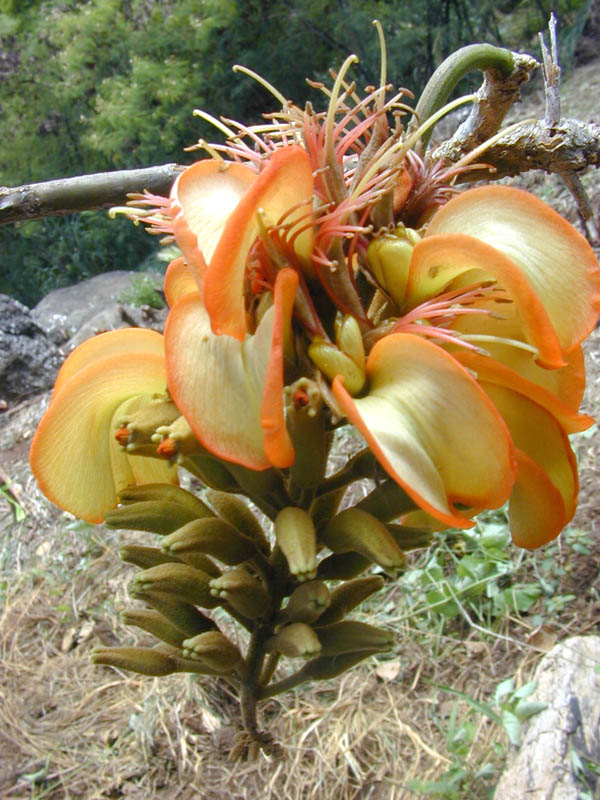- Wiliwili
image_width = 250px
image_caption = Inflorescence of "wiliwili"
regnum =Plant ae
divisio = Magnoliophyta
classis = Magnoliopsida
ordo =Fabales
familia =Fabaceae
subfamilia =Faboideae
tribus =Phaseoleae
genus = "Erythrina "
species = "E. sandwicensis"
binomial = "Erythrina sandwicensis"
binomial_authority = Degener"Wiliwili" ("Erythrina sandwicensis") is a species of tree in the
flowering plant family,Fabaceae . This plant, endemic to theHawaiian Islands , is typically found in dry forests onleeward island slopes up to an elevation of 600 m. Although a number of introduced species of "Erythrina " occur in the Hawaiian Islands, the "wiliwili" is distinguished by a pod with only 1-3 red or yellow-orangeseed s; non-native "Erythrina" (popular street trees in dry areas) have pods with larger numbers of brown seeds. Mature "wiliwili" trees have a distinct orange cast to the bark of the main trunk, caused by a terrestrialalga .The "wiliwili" is summer (dry-season)
deciduous . Typically, the trees lose all of their leaves as the dry season (usually beginning around late April or May) progresses. They then burst intoflower in late August or September. Pods develop and persist on the tree, the seeds being knocked out by heavy downpours that generally start around November in the islands. Many seeds germinate quickly, and a well-established seedling can grow to 4-feet in height before the start of the next dry season.The "wiliwili" is unusual in bearing spines—unusual, because this is a species that has evolved in the isolated Hawaiian Islands in the absence of
ungulate or other largeherbivore s. This species is thought to be closely related to "E. tahitensis", a tree endemic to the Tahitian Archipelago, and "E. velutina", a wide-spread species found in tropicalSouth America and theWest Indies .Lately it has been reported ( [http://www.sciencemag.org/cgi/content/summary/310/5755/1759 Science, 16 December 2005] ) that the Hawaiian wiliwili population is under immediate threat due to an
infestation with aparasitic wasp ,cite web |url= http://www.hanahou.com/pages/magazine.asp?Action=DrawArticle&ArticleID=539&MagazineID=34 |title= The Seed Savers |author= Dennis Hollier |work=Hana Hou! Vol. 10, No. 1. Feb/March 2007 |date= photos by Chris McDonough |quote= ] thegall wasp Quadratichus erythrinae , that invaded Hawaii earlier that year. Theinvasive species appears to have invaded Hawaii via southern Taiwan, Singapore and southern China within only two years.The Hawaiian name of 'wiliwili' means 'repeatedly twisted' and refers to the seed pods which twist open to reveal the seeds.
wiliwili hula chant
Auwe! Pau au i ka mano nui, e!Lala-kea niho pa-kolu.Pau ka papa-ku o Lono.O ka ai ia e ka mano nui,O Niuhi maka ahi,Olapa i ke kai lipo. Ahu e! au-we! A pua ka wili-wili,A nanahu ka mano Auwe! pau ai i ka mano nui! Kai uli, kai ele,Kai popolohua o Kane.A lealea au i ka‘u hula, Pau au i ka mano nui!
Alas! I am seized by the shark, great shark!Lala-kea with triple-banked teeth.The stratum of Lono is gone,Torn up by the monster shark,Niuhi with fiery eyes,That flamed in the deep blue sea.Alas! and alas!When the flowers of the wili-wili tree,That is the time when the shark-god bites.Alas! I am seized by the huge shark!O blue sea, O dark sea,Foam-mottled sea of Kane!What pleasure I took in my dancing!Alas! now consumed by the monster shark!cite web |url= http://www2.bishopmuseum.org/ethnobotanydb/resultsdetailed.asp?search=wiliwili |title= wiliwili |author= Bishop Museum |work=
Hawaii Ethnobotany Online Database |quote= ]References
Wikimedia Foundation. 2010.

